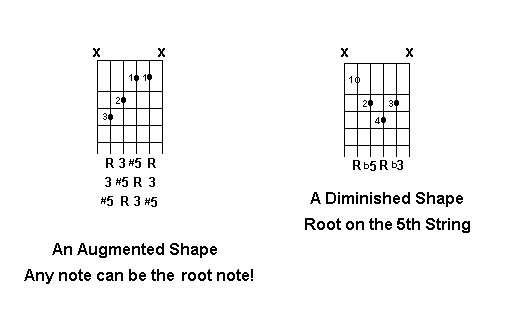

| Major: | R | 3 | 5 |
| Minor: | R | b3 | 5 |
| Diminished: | R | b3 | b5 |
| Augmented: | R | 3 | #5 |



| Chord Number |
Augmented Triad |
Chord Tones
(With Enharmonic Spellings) |
||
|---|---|---|---|---|
| Root | 3 | #5 | ||
| 1 | C+ | C | E | G# |
| E+ | E | G# | B# (C) | |
| G#+ | G# | B# (C) | D## (E) | |
| Ab+ | Ab | C | E | |
| Root | 3 | #5 | ||
| 2 | C#+ | C# | E# (F) | G## (A) |
| Db+ | Db | F | A | |
| F+ | F | A | C# | |
| A+ | A | C# | E# (F) | |
| Root | 3 | #5 | ||
| 3 | D+ | D | F# | A# |
| F#+ | F# | A# | C## (D) | |
| Gb+ | Gb | Bb | D | |
| Bb+ | Bb | D | F# | |
| Root | 3 | #5 | ||
| 4 | D#+ | D# | F## (G) | A## (B) |
| Eb+ | Eb | G | B | |
| G+ | G | B | D# | |
| B+ | B | D# | F## (G) | |
| Key | The Diatonic Triads | ||||||||
|---|---|---|---|---|---|---|---|---|---|
| I | ii- | iii- | IV | V | vi- | vii° | |||
| The Natural Key: | C | C | Dm | Em | F | G | Am | B° | |
| Sharp Keys: | |||||||||
| G | G | Am | Bm | C | D | Em | F#° | ||
| D | D | Em | F#m | G | A | Bm | C#° | ||
| A | A | Bm | C#m | D | E | F#m | G#° | ||
| E | E | F#m | G#m | A | B | C#m | D#° | ||
| B | B | C#m | D#m | E | F# | G#m | A#° | ||
| F# | F# | G#m | A#m | B | C# | D#m | E#° | ||
| C# | C# | D#m | E#m | F# | G# | A#m | B#° | ||
| Key | The Diatonic Chords | ||||||||
| I | ii- | iii- | IV | V | vi- | vii° | |||
| Flat Keys: | |||||||||
| F | F | Gm | Am | Bb | C | Dm | E° | ||
| Bb | Bb | Cm | Dm | Eb | F | Gm | A° | ||
| Eb | Eb | Fm | Gm | Ab | Bb | Cm | D° | ||
| Ab | Ab | Bbm | Cm | Db | Eb | Fm | G° | ||
| Db | Db | Ebm | Fm | Gb | Ab | Bbm | C° | ||
| Gb | Gb | Abm | Bbm | Cb | Db | Ebm | F° | ||
| Cb | Cb | Dbm | Ebm | Fb | Gb | Abm | Bb° | ||